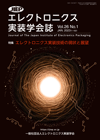Volume 26, Issue 6
Displaying 1-28 of 28 articles from this issue
- |<
- <
- 1
- >
- >|
Preface
-
Article type: Preface
2023Volume 26Issue 6 Pages P6
Published: September 01, 2023
Released on J-STAGE: September 01, 2023
Download PDF (576K)
Special Articles / Japanese Microelectronics Packaging Engineers Working Abroad
-
Article type: Special Articles
2023Volume 26Issue 6 Pages 525
Published: September 01, 2023
Released on J-STAGE: September 01, 2023
Download PDF (676K) -
Article type: Special Articles
2023Volume 26Issue 6 Pages 526-529
Published: September 01, 2023
Released on J-STAGE: September 01, 2023
Download PDF (1359K) -
Article type: Special Articles
2023Volume 26Issue 6 Pages 530-533
Published: September 01, 2023
Released on J-STAGE: September 01, 2023
Download PDF (1087K) -
Article type: Special Articles
2023Volume 26Issue 6 Pages 534-537
Published: September 01, 2023
Released on J-STAGE: September 01, 2023
Download PDF (1337K) -
Article type: Special Articles
2023Volume 26Issue 6 Pages 538-543
Published: September 01, 2023
Released on J-STAGE: September 01, 2023
Download PDF (1912K) -
Article type: Special Articles
2023Volume 26Issue 6 Pages 544-550
Published: September 01, 2023
Released on J-STAGE: September 01, 2023
Download PDF (2106K) -
Article type: Special Articles
2023Volume 26Issue 6 Pages 551-555
Published: September 01, 2023
Released on J-STAGE: September 01, 2023
Download PDF (1143K) -
Article type: Special Articles
2023Volume 26Issue 6 Pages 556-560
Published: September 01, 2023
Released on J-STAGE: September 01, 2023
Download PDF (3388K) -
Article type: Special Articles
2023Volume 26Issue 6 Pages 561-568
Published: September 01, 2023
Released on J-STAGE: September 01, 2023
Download PDF (2326K) -
Article type: Special Articles
2023Volume 26Issue 6 Pages 569-570
Published: September 01, 2023
Released on J-STAGE: September 01, 2023
Download PDF (795K) -
Article type: Special Articles
2023Volume 26Issue 6 Pages 571-576
Published: September 01, 2023
Released on J-STAGE: September 01, 2023
Download PDF (1599K) -
Article type: Special Articles
2023Volume 26Issue 6 Pages 577-581
Published: September 01, 2023
Released on J-STAGE: September 01, 2023
Download PDF (1036K) -
Article type: Special Articles
2023Volume 26Issue 6 Pages 582-585
Published: September 01, 2023
Released on J-STAGE: September 01, 2023
Download PDF (883K) -
Article type: Special Articles
2023Volume 26Issue 6 Pages 586-589
Published: September 01, 2023
Released on J-STAGE: September 01, 2023
Download PDF (844K)
2022 JIEP Award-Technical Development
-
2023Volume 26Issue 6 Pages 590-597
Published: September 01, 2023
Released on J-STAGE: September 01, 2023
Download PDF (2108K)
Technical Paper
-
Article type: Technical Paper
2023Volume 26Issue 6 Pages 598-605
Published: September 01, 2023
Released on J-STAGE: September 01, 2023
Advance online publication: June 30, 2023Download PDF (1407K)
Tutorial Series - 3D Integration & Packaging Course / (6)
-
Article type: Tutorial Series
2023Volume 26Issue 6 Pages 606-612
Published: September 01, 2023
Released on J-STAGE: September 01, 2023
Download PDF (2660K)
Report
-
Article type: Report
2023Volume 26Issue 6 Pages 613
Published: September 01, 2023
Released on J-STAGE: September 01, 2023
Download PDF (903K)
Report
-
Article type: Report
2023Volume 26Issue 6 Pages 616-617
Published: September 01, 2023
Released on J-STAGE: September 01, 2023
Download PDF (652K)
2023 JIEP Award
-
2023Volume 26Issue 6 Pages 618-627
Published: September 01, 2023
Released on J-STAGE: September 01, 2023
Download PDF (2078K)
Announcement, Contents, etc.
-
Article type: Announcement
2023Volume 26Issue 6 Pages 614-615
Published: September 01, 2023
Released on J-STAGE: September 01, 2023
Download PDF (1095K) -
Article type: Announcement
2023Volume 26Issue 6 Pages 628-630
Published: September 01, 2023
Released on J-STAGE: September 01, 2023
Download PDF (1152K) -
Article type: Announcement
2023Volume 26Issue 6 Pages 631-632
Published: September 01, 2023
Released on J-STAGE: September 01, 2023
Download PDF (780K) -
Article type: Announcement
2023Volume 26Issue 6 Pages A61-
Published: September 01, 2023
Released on J-STAGE: September 01, 2023
Download PDF (622K) -
Article type: Announcement
2023Volume 26Issue 6 Pages C61
Published: September 01, 2023
Released on J-STAGE: September 01, 2023
Download PDF (606K) -
Article type: Announcement
2023Volume 26Issue 6 Pages C62
Published: September 01, 2023
Released on J-STAGE: September 01, 2023
Download PDF (554K) -
Article type: Announcement
2023Volume 26Issue 6 Pages I61-
Published: September 01, 2023
Released on J-STAGE: September 01, 2023
Download PDF (894K)
- |<
- <
- 1
- >
- >|
